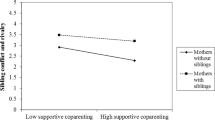Abstract
A structural equation model (SEM) examined interrelationships among psychosocial variables known to affect the health and development of well siblings and parents when a child with a chronic illness or disability is a member of the family. Using dyads of 252 well children and parents, socioeconomic status (SES) and family cohesion were associated with the parent-reported behavior of the well sibling. SES also influenced the mood of the mother that in turn influenced family cohesion. The well sibling's knowledge about the illness of the brother or sister, attitude toward the illness, mood, self-esteem, and feelings of social support were interrelated and related to the behavior of the well sibling. The SEM suggests that interventions may be directed at several points in these interactions including boosting knowledge levels of the well sibling, improving family cohesion, and assuring adequate “income” support to the family through income transfers or in-kind services.
Similar content being viewed by others
REFERENCES
Arbuckle, J. A. (1999). AMOS 4 User's Guide, SPSS Inc., Chicago.
Breslau, N., and Prabucki, K. (1987). Siblings of disabled children: Effects of chronic stress in the family. Arch. Gen. Psych. 44: 1040–1046.
Eyberg, S., and Robinson, E. (1983). Conduct problem behavior: Standardization of a behavior rating scale with adolescents. J. Clin. Child Psych. 12: 347–354.
Graff, J. C. (2001). An Evaluation of a Modified Iintervention for Siblings of Children With Chronic Illness/Disability. Unpublished Ph.D. Dissertation, University of Kansas School of Nursing, Kansas City.
Harter, S. (1983). Developmental perspectives on the self-system. In Mussen, P. (Ed.), Handbook of Child Psychology,Vol. 4: Socialization,Personality, and Social Development,Wiley, New York, pp. 276–285.
Harter, S. (1885a). Manual for the Self-Perception Profile for Children, University of Denver, Denver.
Harter, S. (1985b). Manual for the Social Support Scale for Children, University of Denver, Denver.
Hobbs, N., and Perrin, J. (1985). Chronically Ill Children and Their Families, Jossey-Bass, San Francisco.
Jaccard, J., and Wan, C. K. (1996). LISREL Approaches to Interaction Effects in Multiple Regression, Sage, Thousand Oaks, CA.
Levy, P., and Lemeshow, S. (1991). Sampling of Populations: Methods and Applications,Wiley, New York.
Lynch, J., and Kaplan, G. (2000). Socioeconomic position. In Berkman, L., and Kawachi, I. (Eds.), Social Epidemiology, Oxford University Press, New York, pp. 13–35.
McNair, D., Lorr, M., and Droppleman, L. (1992). POMS Manual: Profile of Mood States, EdiTS, San Diego, CA.
Moody, L., McCormick, K., and Williams, A. R. (1990).Disease and symptom severity, functional status, and quality of life in chronic bronchitis and emphysema (CBE). J. Behav. Med. 13: 297–306.
Olson, D., Portner, J. and Lavee, Y. (1985). Family Adaptability and Cohesion Evaluation Scales, University of Minnesota, St. Paul.
Prochaska, J., and Velicer, W. (1997). The theoretical model of health behavior change. Am. J. Health Promo. 12: 38–48.
Sahler, O., and Carpenter, P. (1989). Evaluation of a camp program for siblings of children with cancer. Am. J. Diseases Child. 143: 690–696.
Stein, R., and Jessop, D. (1989). What diagnosis does not tell: The case for a noncategorical approach to chronic illness in childhood. Soc. Sci. Med. 29: 769–778.
Williams, A., and DeLurgio, S. (1994). Path analysis: Reflections on causal modeling. In McCormick, K. A., Moore, S. R., and Siegel, R. A. (Eds.), Clinical Practice Guideline Development: Methodology Perspectives, AHCPR 95-0009,Washington, DC, pp. 77–84.
Williams, P. (1997). Siblings and pediatric chronic illness: Review of the literature. Int. J. Nurs. Stud. 34: 312–323.
Williams, P., and Williams, A. (2000). Individual, Family and Community: Promoting and Restoring Health and Well-Being, JMC Press, Quezon City, Philippines.
Williams, P., Williams, A., Hanson, S., Graff, C., Ridder, L., Curry, H., Liebergen, A., and Karlin-Setter, R. (1999). Maternal mood, family functioning, and perceptions of social support, self-esteem, and mood among siblings of chronically ill children. Child. Health Care 28: 297–310.
Author information
Authors and Affiliations
Corresponding author
Rights and permissions
About this article
Cite this article
Williams, P.D., Williams, A.R., Graff, J.C. et al. Interrelationships Among Variables Affecting Well Siblings and Mothers in Families of Children with a Chronic Illness or Disability. J Behav Med 25, 411–424 (2002). https://doi.org/10.1023/A:1020401122858
Issue Date:
DOI: https://doi.org/10.1023/A:1020401122858




